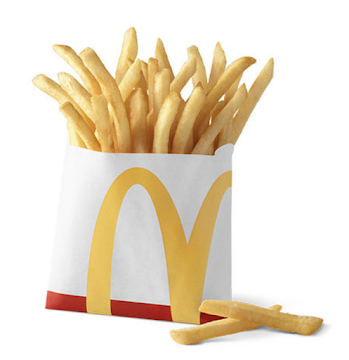Most mornings I spend several hours scouring the Internet for new recipes to keep me mo-tivated. As you can imagine, I have a file that is overflowing. Several, in fact. Will I make all these recipes? It is impossible.
Be that as it may, I've decided to post and share those I find interesting, even though I have not prepared them.
I begin with fries.
Not any fries, but McDonald's fries which, if you are as old as me, you remember fondly opposed to the limp ones served today. Often cold.
But first, let's talk lard and fat. Lard is from pigs. Tallow is from beef. People often use the terms interchangeably. That is not correct.
I love lard and use it often, along with bacon grease. Here are some facts to consider: The newer lards are much healthier then they used to be. I use it in biscuits, pie crusts, and to grease bread pans and casserole dishes.
One tablespoon of lard has 10 mg of cholesterol. By contrast, one tablespoon of butter has 30mg of cholesterol. What about fat content? Well, one tablespoon of lard has 13% fat, of which six is saturated fat. By contrast, one tablespoon of butter has 11% fat, of which seven is from saturated fat. One tablespoon of margarine has 11% percent fat of which 2.1% is saturated but contains no cholesterol. One tablespoon of Crisco all-vegetable shortening is 12g of total fat of which 3 is saturated fat but contains no cholesterol.
The culprit with fat is hydrogenated fats, also known as "trans-fat" which raises bad cholesterol and lowers good cholesterol. Hydrogenation is the industrial process of adding hydrogen to oil to turn it into a solid so it has a longer and more stable shelf life. Crisco is an example. As is margarine.
Prior to WWII most American kitchens used lard. My father fondly recounted how a treat during The Great Depression was a piece of bread spread with lard and sprinkled with sugar. After WWII, lard fell out of favor as margarines hit grocery stores. It was considered "classier."
It is now possible to buy lard without any trans-fat in it at all. When McDonald's decided to substitute vegetable oil for animal fat, it was at the height of the trans-fat controversy that swept the country. To appease public opinion, they switched to oil.
The fat that McDonald's used was called Tallow 47, which was a blend of 97% lard with 3% vegetable oil. It was inexpensive. Why "47?" That was the price for a complete "meal" back then ... ł5 cents for a hamburger, 12 cents for fries and 20 cents for a milkshake.
- 2 large Idaho russet potatoes
- 1/4 cup sugar
- 2 tablespoons corn syrup
- Formula 47 (6 cups beef tallow, ½ cup canola oil)
- Salt
Peel the potatoes. In a large mixing bowl, combine sugar, corn syrup, and hot water. Make sure the sugar is dissolved.
Cut the peeled potatoes into shoestrings. The potatoes should be 1/4'x 1/4" in thickness, and about 4" to 6" long.
Place the shoe-stringed potatoes into the bowl of sugar-water, and refrigerate. Let them soak for 30 minutes. While they're soaking, pack the tallow into the deep fryer.
When it is at least 375° F, drain the potatoes. Pat dry. Place into fryer. After 1 1/2 minutes, remove the potatoes and place them on a paper towel lined plate. Let them cool for 8 to10 minutes in the refrigerator.
After the deep fryer is reheated to 375°-400°, add the potatoes and deep fry again for 5-7 minutes until golden brown. Remove and place in a large bowl. Sprinkle generously with salt, then "toss" the fries to mix the salt evenly.
Depending upon the size of the potatoes, this recipe makes about 2 medium sized fries.
Here's the video I watched.



No comments:
Post a Comment